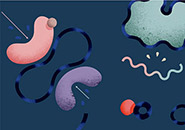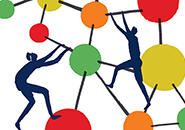Summary
HHMI broadens its research support with the announcement of a new program to foster collaboration and innovation.
Surprising—sometimes groundbreaking—findings can emerge when scientists follow ideas that stray from the primary path of their research. But these promising detours may prove challenging to pursue for scientists who need to marshal time, expertise, and resources in a constrained funding environment that favors more predictable research proposals.
A $10 million pilot program ($10 million per year, totaling $40 million over four years) from the Howard Hughes Medical Institute will now enable eight teams of scientists to devote substantial time and energy to pursuing collaborative, potentially transformative research. The Collaborative Innovation Awards represent a shift for HHMI because they represent the first time the Institute will provide direct funding for specific research projects. They are intended to encourage both HHMI investigators and scientists outside HHMI to undertake projects that are new and so large in scope that they require a team of collaborators with a range of expertise.
“We're excited about this program because of the quality of the projects, but also because it broadens the community of scientists supported by HHMI,” said Thomas R. Cech, president of HHMI. “It incorporates people outside of the HHMI investigator program in solving important problems, and lets us do something really new.”
Eight teams of three to six scientists, each headed by an HHMI investigator, will bring together their diverse expertise to explore a wide range of potentially transformative research areas. These include development of an ultraminiature implantable wireless sensor for monitoring progression of glaucoma; the identification of drugs capable of clearing toxic brain proteins that cause neurodegenerative diseases; and determining whether the study of gene regulation in ants can be used as a model for human aging.
“This program allows scientists to attack problems that one person can't solve,” said Jack Dixon, HHMI's vice president and chief scientific officer. “To study many of today's scientific problems with the kind of depth that is needed, you have to be willing to explore areas in which you are not an expert. That means you have to either become an expert in those areas, or find out who is the best in the world in that area and persuade them to work with you. This award permits our investigators to assemble the teams of experts they need to attack these complex scientific problems.”
The eight projects were selected from among 62 proposals submitted by HHMI investigators and will bring together a total of 33 researchers from 16 institutions in the United States and Chile. The Institute will evaluate the success of the eight projects selected in this pilot phase, and expects to expand the program in coming years.
Dixon said the Institute placed an “enormous emphasis on innovation” in evaluating the proposals. “We were looking for projects that could really represent breakthroughs—those that could really change the way we think. We were looking for projects that explore new biology that really has not been tested at all,” he continued.
HHMI expects recipients of the Collaborative Innovation Awards to take on projects that are not only ambitious, but also scientifically daring. While HHMI investigators are always free to pursue research paths that are not guaranteed success, taking on these types of projects can be difficult for researchers who must seek grants to fund them. By incorporating researchers who are not HHMI employees into the collaborative teams receiving these new awards, HHMI wants to encourage this type of potentially transformative research among a wider community of scientists. Not every one of these projects will succeed. But they will all contribute new knowledge, research tools, or ways of thinking about biological problems.
For example, the five scientists working with HHMI investigator Xiaowei Zhuang at Harvard University have all developed cutting-edge technologies for imaging, data analysis, and sample preparation that have redefined the limits of what scientists can learn by looking through a light microscope. With their Collaborative Innovation Award, Zhuang and her colleagues will rework those techniques so that they are compatible with one another and can be combined to tackle the daunting task of thoroughly mapping a mammalian brain.
Up the coast from Zhuang, in Bar Harbor, Maine, HHMI investigator Simon John is working to revolutionize treatment for glaucoma. Glaucoma is a major cause of blindness, and high pressure inside the eye contributes to its development. John, who is at The Jackson Laboratory, is teaming with two engineers at Purdue University who are leaders in the design and fabrication of implantable integrated circuits and antennas for wireless sensor networks. If successful, the group will work together to create a wireless sensor so tiny that it can be implanted into the eye of a mouse to provide constant monitoring of intraocular pressure. They hope their device will be a prototype for new sensors that might one day be used in humans to monitor blood pressure around the clock.
Philip Perlman, a senior scientific officer at HHMI who is overseeing the program, said HHMI developed the Collaborative Innovation Awards because it recognized there was a need for a creative funding mechanism to support these large-scale collaborations. Although short-term collaborations between individuals are common within the scientific community, larger collaborative projects can sometimes be seen as detracting from a laboratory's primary focus, he noted. “Many research groups can find it difficult to allocate the resources to allow one or more members to devote years to a project that could yield important results, but may never directly further the lab's own mission.”
The financial support offered by the Collaborative Innovation Awards has enabled the lead investigators to assemble teams of scientists with the knowledge and skills necessary to explore the important questions that pique their scientific curiosity - and to assure that the funding is available to see those projects through for up to four years. Each collaborator will receive funds from HHMI to cover their research budget, including the purchase of new equipment if needed.



